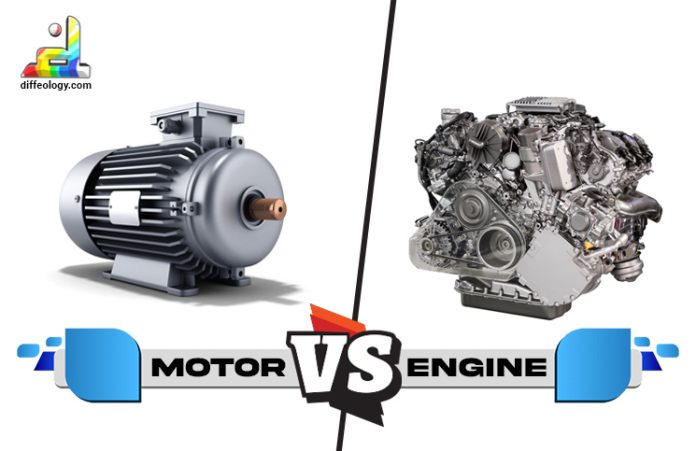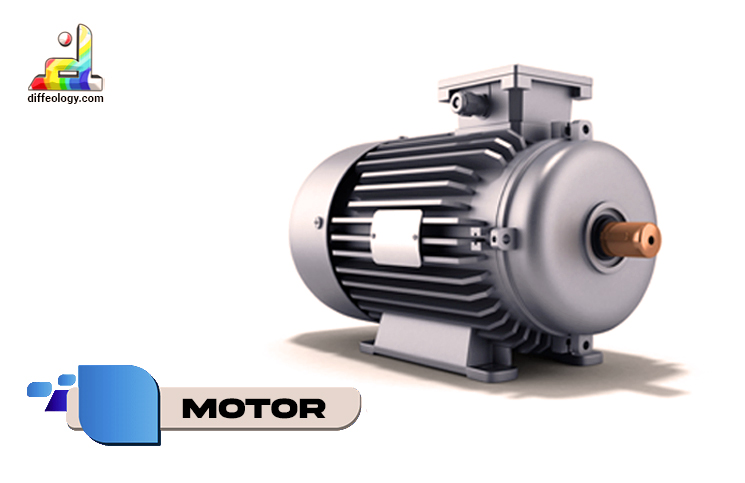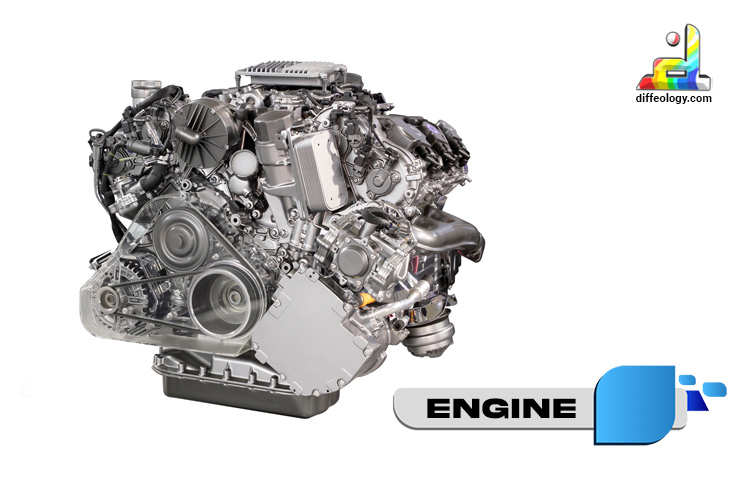Understanding the Difference Between Motor and Engine is simple. The engines and motors have a wide variety of global uses. They have several uses in manufacturing, transportation, and the home. An engine gets its power from the chemical reaction between air and fuel, whereas a motor gets its power from electricity. An engine or motor is a mechanism that transfers energy into mechanical motion. The primary focus of this article is to define the distinction between a motor and an engine.
Motors are usually the electric ones that run on electricity, while engines are the ones you find in cars, trucks, planes, and boats, and they run on things like gasoline or diesel.
You see, motors are the things in electric appliances, electric cars, and machines in factories, while engines are in regular cars, trucks, planes, and boats.
Main Difference Between Motor and Engine
Motors are awesome for stuff that needs to keep going steadily and be super precise, but engines are better for things that need bursts of power and changing speeds. You’ll find motors in things that sit still or can be carried around, like gadgets, tools, or big machines in factories, while engines are all about making vehicles move and generating electricity.
Motor Vs. Engine
What is a Motor?
A motor is a clever contraption that helps things move with the magic of electricity. You see, in the world of gadgets and gizmos, we often need a way to turn electrical energy into actual movement – that’s where motors come into play. Now, let me break it down for you.
First off, a motor is like an obedient servant that listens to your commands. When you flip a switch or press a button, it wakes up and gets to work. It uses the power of electricity, which is like a bunch of tiny, invisible workers called electrons, to create a special kind of power. This power creates something called a magnetic field, which is like an invisible force that can push and pull things. Imagine a magnet pulling a paperclip – that’s what a motor does to make things move.
Read Also: Difference Between Steel and Alloy Wheels
Secondly, motors are all around us, from your trusty blender in the kitchen to the wheels of your remote-controlled car. They make our lives easier by turning electrical energy into motion. Think about your electric fan; when you turn it on, the motor inside spins the blades, creating a breeze that cools you down on a hot day. It’s like having a little helper making things happen at the flick of a switch.
Lastly, motors come in all shapes and sizes, depending on the job they need to do. Some are small and precise, like the one in a robot’s arm, which helps it pick up things delicately. Others are big and powerful, like the ones in construction equipment that can lift heavy loads. So, whether it’s your toy train racing around a track or a massive crane hoisting tons of steel beams, motors are there to lend a hand and turn electricity into motion – making our world go round.
What is an Engine?
An engine is like the heart of a machine that helps it go vroom-vroom and do all sorts of work. It’s a bit like the power plant that gives life to vehicles like cars, trucks, and even airplanes. Let me break it down for you in simple terms.
First of all, an engine is a bit like a hungry beast that needs to eat to work. Instead of food, it gobbles up something called fuel, like gasoline or diesel. This fuel is mixed with a dash of air, and then, something magical happens. The engine ignites this mixture and creates fiery explosions inside its chambers. These explosions produce a lot of energy, which is then transformed into mechanical power. Imagine it like controlled mini-explosions that push and pull parts inside the engine, making everything move.
Read Also: Difference Between Laser and Optical Mouse
Secondly, engines have a crucial job—they make things move with serious force. For example, in a car, the engine takes all that power it created from those controlled explosions and sends it to the wheels. This power is what propels the car forward or backward, depending on if you’re hitting the gas or the brakes. Think of the engine as the muscle that gets your vehicle rolling, whether it’s a small scooter or a massive locomotive.
Lastly, engines come in different flavors. Engines built for speed can propel sports cars to incredible velocities, while those designed for heavy-duty work power the engines in large trucks, enabling them to haul substantial loads. Airplanes also have their engines specially engineered to keep these massive birds soaring through the sky. So, engines are like the muscle-bound, energy-churning powerhouse that turns fuel into the incredible motion you see in all sorts of machines.
Difference Between Motor and Engine in Detail
1. Terminology:
When we talk about a “motor,” we’re usually talking about an electric gizmo that takes that electrical juice and turns it into good old-fashioned mechanical moving and shaking. You’ll find these motors all over the place, from your household appliances to your trusty car, all thanks to some fancy electromagnetic doohickies.
Now, an “engine” that’s a whole other story. Engines are those big, burly contraptions that guzzle up fuel like it’s going out of style. Gasoline, diesel, or even natural gas—they’ll burn whatever they can get their hands on to create explosions and crank out that mechanical power. They’re the heart and soul of cars, trucks, and planes, making them go vroom-vroom.
2. Firepower:
Motors are thirsty for one thing and one thing only: electricity. They’re hooked up to batteries or some other power source, and they make things move by using electrons to create magnetic fields. There are no explosions, just good magnetic magic.
Engines, my buddy, they hunger for fuel and air. They function similarly to dragons that breathe fire, but instead of flames, they produce high-pressure gases by consuming fuel rapidly. These blazing eruptions are what really set things moving.
3. Fuel:
Now, here’s the kicker: motors don’t touch traditional fuels with a ten-foot pole. They’re clean and green and don’t spit out emissions when they work their magic. That’s why folks say they’re better for Mother Earth.
Engines, well, they’re not exactly known for being eco-friendly. They chug down gasoline or diesel-like there’s no tomorrow, belchin’ out stuff like carbon dioxide, nitrogen oxides, and little dirt and soot particles.
4. Quiet or Ruckus:
When it comes to noise and vibes, motors are the strong, silent type. They don’t make much noise or shake things up, which is perfect for hush-hush jobs like electric cars.
Internal combustion engines, on the other hand, can raise a ruckus. All those explosions happening inside the cylinders can make quite a commotion and send vibrations through the machine.
5. Efficiency Matters:
Motors are the efficiency champs. They can turn over 90% of that electrical energy into pure mechanical work, which means they don’t waste much energy.
Engines, well, they’re a bit of a gas guzzler. They operate around 20-30% efficiency, which means a good chunk of the energy from fuel goes up in smoke, literally.
6. Maintenance Blues:
Motors are low-maintenance buddies. With fewer moving parts and no complicated fuel systems, they don’t need as much TLC.
Engines can be high-maintenance pals. They need regular oil changes, spark plug swaps, and fuel system check-ups because all that fiery action can wear them down.
7. Green Machine or Smog Monster:
Motors are the heroes of the environment. They don’t spew out any nasty stuff at the tailpipe, but remember, their green cred depends on where that electricity comes from.
Engines can be the bad boys when it comes to the environment. They pump out pollutants that mess with our air quality and climate. Folks are trying to clean them up with cleaner fuels and hybrid tech, though.
8. Speed and Torque:
Now, when it comes to speed and torque, motors are like a sprinter with a rocket booster. They can spin really fast and provide instant torque, which makes them great for zipping around in electric vehicles.
Engines, on the other hand, are more like a heavyweight champ. They might not hit that top speed as quickly, but they can keep on chugging for longer periods, especially those big, honking diesel engines in heavy-duty trucks.
9. Size Matters:
Motors are compact and can be tucked away in all sorts of nooks and crannies. You’ll find them hidden in your washing machine, quietly doing their thing.
Engines are a bit of a space hog. They need room to breathe and lots of components like pistons, cylinders, and exhaust systems. That’s why you won’t find them in your dishwasher anytime soon.
10. Instant On vs. Warm-Up Time:
Motors are ready to roll as soon as you flip that switch. No need for a warm-up act. They’re like that friend who’s always on time.
Engines, well, they need a moment to wake up. You have to let them idle and warm up, especially on chilly mornings, before they’re raring to go.
11. Fuel Storage:
Motors don’t require a stash of fuel. Just plug them in or hook them up to a battery, and they’re good to go.
Engines need a stash of fuel on board, whether it’s in a gas tank or a diesel tank. You have to fill them up to keep them running.
12. Heat Production:
Motors keep their cool. They don’t generate much heat, which is great for keeping things from overheating.
Engines are like little heat factories. All those explosions happening inside can make them hotter than a summer day in Texas, which is why they need cooling systems.
13. Complexity of Operation:
Operating a motor is as easy as flipping a switch. You give them power, and they do their thing—no need for complex ignition systems or fuel mixture adjustments.
Engines can be a bit finicky. You have to get the fuel-air mix just right and spark that spark plug at the precise moment to get them hummin’. It’s like playing a tune on a fiddle.
14. Versatility:
Motors are versatile critters. They can spin, turn, and move in all sorts of ways, making them perfect for a wide range of applications, from your blender to your electric skateboard.
Engines are more specialized. They’re built for specific tasks, like moving a car or a plane, and they’re not as handy for tasks that require precise control and instant responses.
15. Starting in Cold Weather:
Motors aren’t scared of no cold weather, partner. They’ll crank up and get to work without a fuss, even on chilly winter mornings.
Engines can be a bit grumpy when it’s cold. You might need to use block heaters or let them warm up for a while before they’re ready to roar, especially in freezing temps.
16. Range and Refueling:
Motors offer a range that’s pretty predictable. You charge them up, and you know how far you can go. No need for guesswork.
Engines, well, their range depends on how much fuel you’ve got in the tank. You have to keep an eye on that gas gauge and make pit stops for refueling.
17. Weight and Power-to-Weight Ratio:
Motors are like featherweights. They’re light and can pack a punch in terms of power, which is great for efficiency and speed.
Engines can be real heavyweights. They’ve got more mass, and that can affect power-to-weight ratios, making them a bit beefier but potentially less nimble.
18. Environmental Conditions:
Motors can handle a wide range of environmental conditions without breaking a sweat. Rain, shine, or snow, they keep on trucking.
Engines can be a bit more sensitive. Extreme conditions, like high altitudes or really hot weather, might make them huff and puff a bit.
19. Control and Precision:
Motors are like precision instruments. They can be controlled with pinpoint accuracy, which is why you’ll find them in robotics and other applications where precision matters.
Engines are a bit like rough-and-tumble cowboys. They might not be as precise in their movements, which is why you won’t see them in tasks that require surgical precision.
20. Power Delivery:
Motors deliver power smoothly and instantly. When you hit the gas pedal in an electric car, there’s no delay—it’s like a bolt of lightning.
Engines can have a bit of lag. There’s often a delay between when you hit the gas and when the power really kicks in, especially in older vehicles.
21. Energy Storage and Density:
Motors rely on batteries for energy storage. While batteries are getting better, they still can’t match the energy density of liquid fuels used in engines.
Engines have the upper hand when it comes to energy density. A small amount of liquid fuel can store a lot of energy, which is why they’re still widely used for long-range travel.
Comparison Table “Motor Vs. Engine”
| Reasons of Distinctions | Motor | Engine |
|---|---|---|
| Power Source | Electricity, no fuel required. | Fuel (gasoline, diesel, etc.) is essential. |
| Emissions | Environmentally friendly, no emissions. | Emissions include CO2, NOx, and particulates. |
| Noise and Vibration | Quiet and low-vibration. | It can be noisy, with noticeable vibrations. |
| Efficiency | High efficiency (over 90%). | Lower efficiency (20-30%). |
| Maintenance | Low maintenance. | Requires regular maintenance. |
| Environmental Impact | Green depends on the electricity source. | It can be environmentally harmful. |
| Speed and Torque | Quick acceleration, instant torque. | Slower acceleration, high torque. |
| Size | Compact and versatile. | Larger and space-consuming. |
| Instant Start | Immediate start, no warm-up needed. | Requires warm-up time before optimal performance. |
| Fuel Storage | No fuel storage is required. | Needs onboard fuel storage (tank). |
| Heat Production | Minimal heat generation. | Generates significant heat, needs cooling. |
| Complexity of Operation | Simple operation, no complex systems. | Requires precise ignition and fuel mixture. |
| Versatility | Versatile, suitable for various applications. | Specialized for specific tasks. |
| Cold Weather Start | Works well in cold weather. | It may need warming up in cold conditions. |
| Range and Refueling | Predictable range, no refueling needed. | Range depends on fuel and requires refueling. |
| Weight and Power Ratio | Lightweight with good power-to-weight ratio. | Heavier with potentially lower power-to-weight. |
| Environmental Tolerance | Resilient in various conditions. | Sensitive to extreme environmental conditions. |
| Control and Precision | Highly precise control. | Less precise in movements. |
| Power Delivery | Smooth and instant power delivery. | Can have a lag in power delivery. |
| Energy Storage | Battery-based energy storage. | Liquid fuels with high energy density. |
Key Points Showing the Difference Between Motor and Engine
- So, a motor basically takes electricity and turns it into motion, while an engine takes different kinds of stuff, like gas or heat, and turns that into motion.
- Motors are simple, with not too many moving parts, while engines are like a puzzle with lots of stuff moving around, like pistons and valves.
- Motors can give you power right away, even at slow speeds, but engines might take a little time to really get going.
- And motors are quiet and don’t make much mess, but engines can be noisy, and they shoot out exhaust fumes.
- Motors are great at turning electricity into power, but engines, well, they can be okay or not so great, depending on how they’re built and what they run on.
- Motors are super-efficient; they can use most of the electricity, but engines, especially the ones that use gas, aren’t as good at turning their fuel into power.
- Motors have a nice, smooth relationship between how fast they spin and how much they can push or pull, which is good for stuff that needs to move just right. Engines, well, they’re a bit more complicated.
- Motors need electricity all the time to work, but engines can carry their fuel, so they’re handy for things that need to move around a lot.
- Motors are pretty low-maintenance, not much to worry about, but engines need regular check-ups, oil changes, and stuff like that.
- Oh, and motors are nice to the planet because they don’t make any bad stuff when they run, but engines, especially the ones in cars, put out greenhouse gases and other dirty stuff.
FAQs:
Conclusion
Motors are like instant action heroes, quick and powerful at slow speeds, which is why they’re great for electric cars. Engines, well, they take a bit to get going and need fancy gearboxes to match.
Changing the direction of a motor is a piece of cake; just switch the current, but engines need a whole system to go backward. You’ll often see motors in things like wind turbines and solar panels because they’re awesome at turning natural energy into electricity. Engines, not so much because they need their fuel.
Engines have a unique sound and can shake things around, but motors run smoothly and quietly. Motors are typically electric devices that convert electrical energy into mechanical motion and are known for their efficiency and low environmental impact. In contrast, engines are devices that often rely on the combustion of fuels and are associated with higher emissions and maintenance requirements. The main Difference Between Motor and Engine lies in their operating principles, energy sources, and environmental impact.



